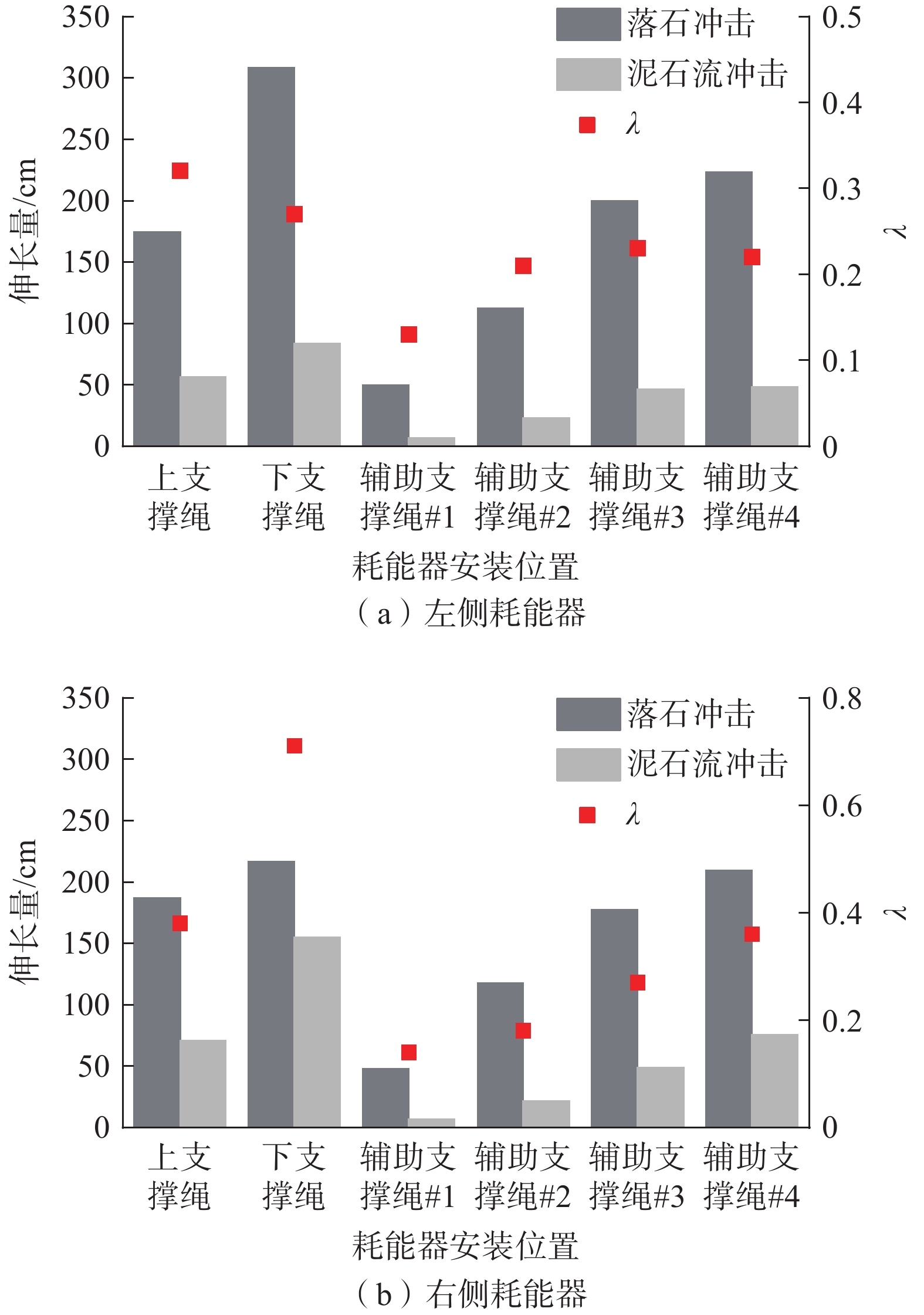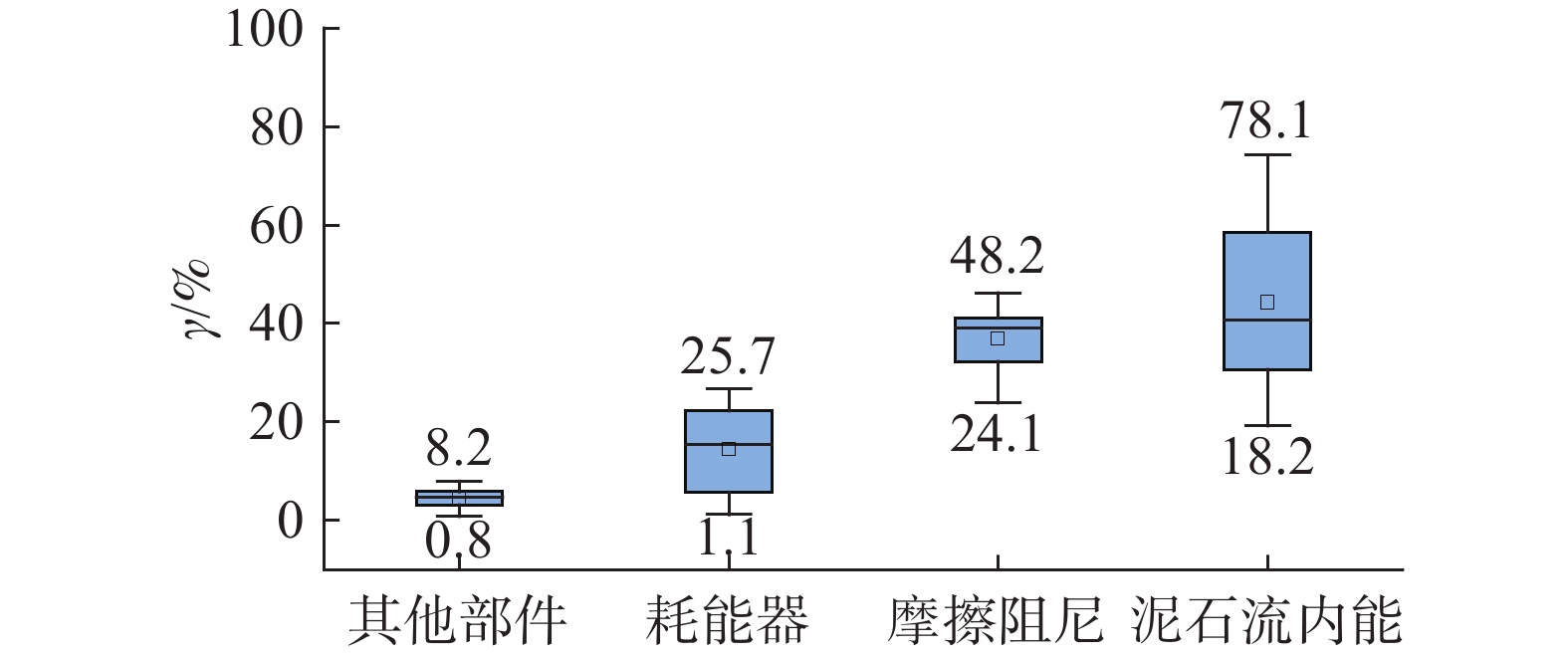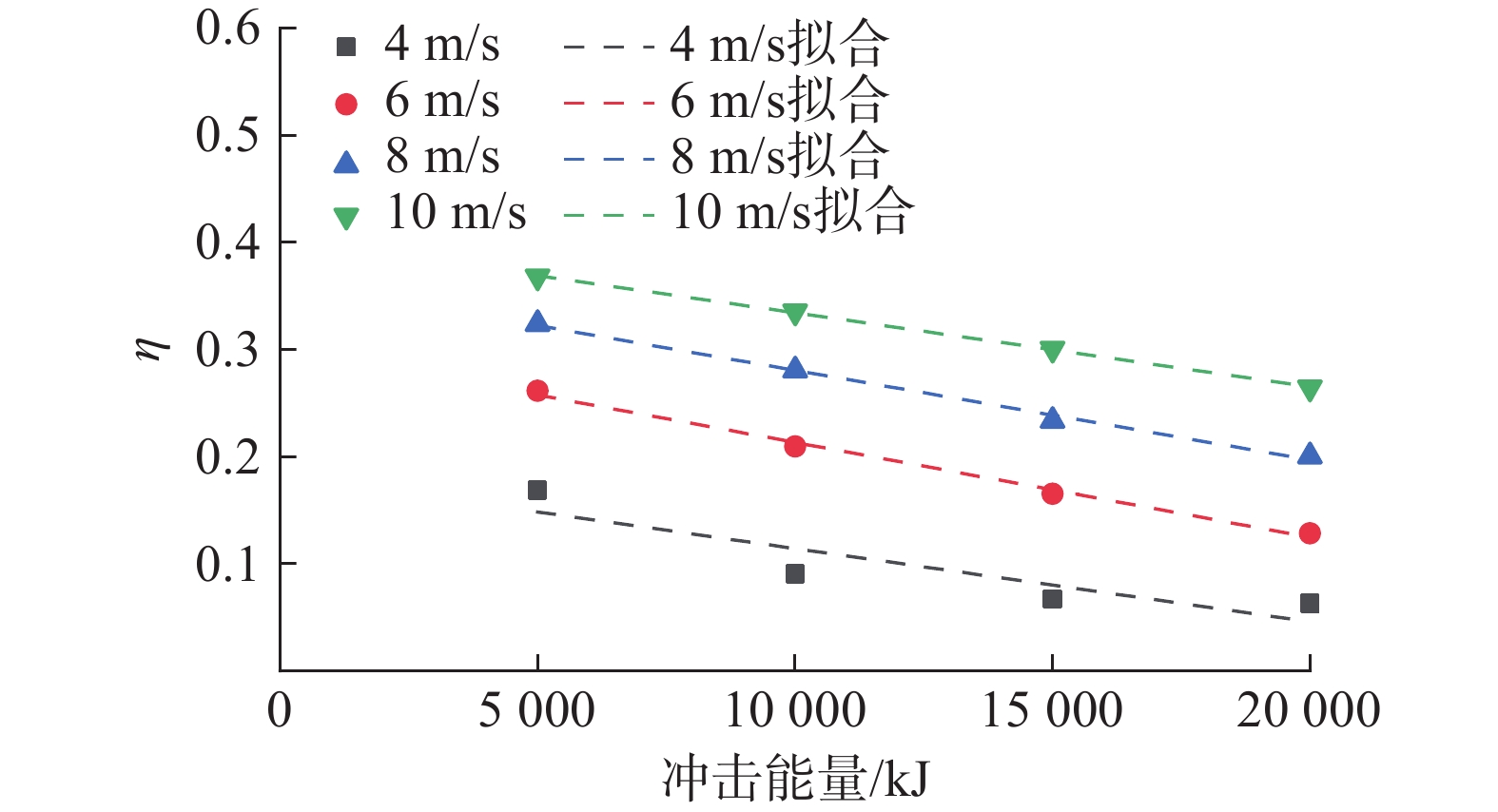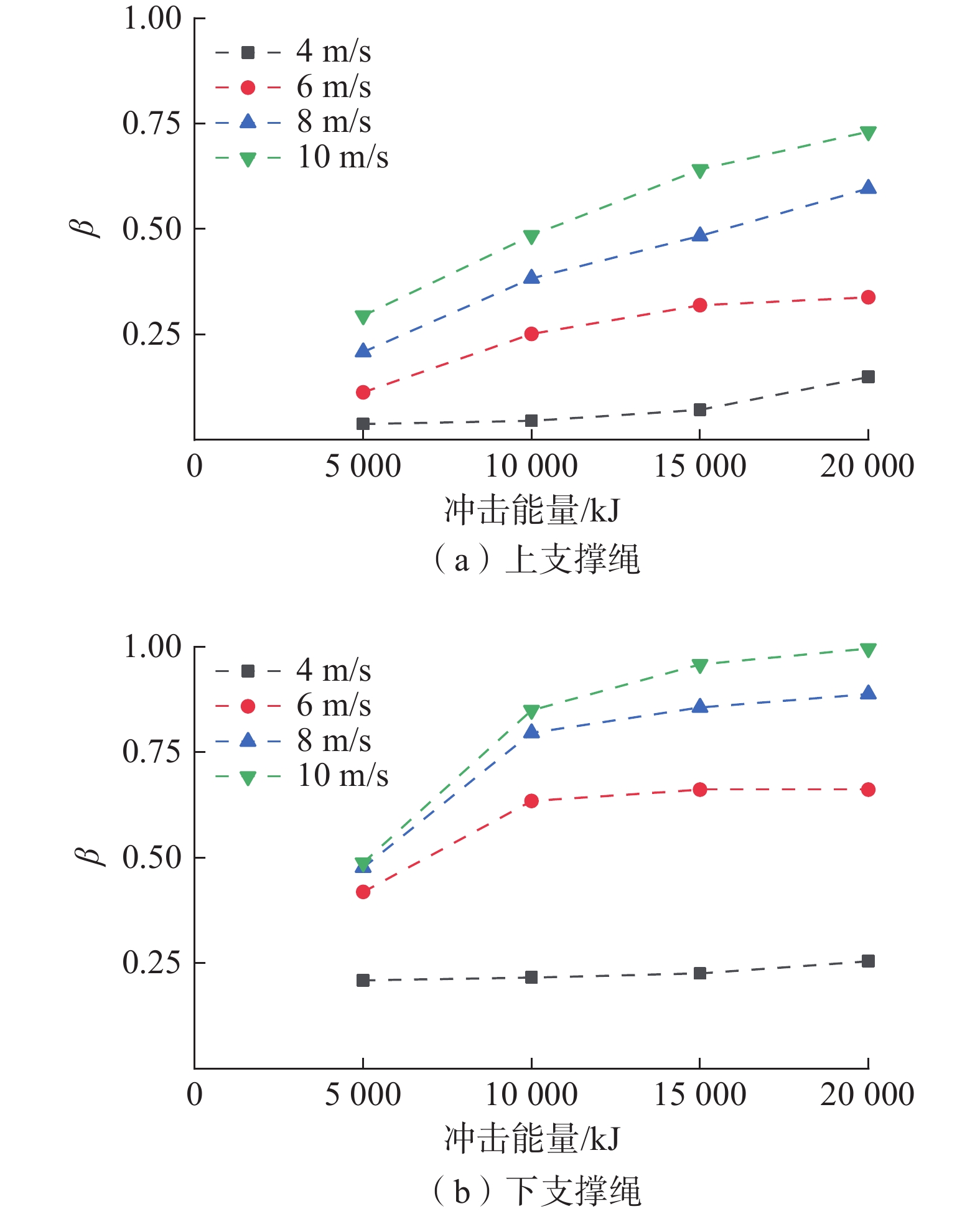Coupled dynamic response analysis of a flexible barrier under slope debris flow impact
-
摘要:
目前,被动柔性防护网相关性能检验仅针对落石冲击场景,在坡面泥石流冲击作用下,其耦合动力响应的研究匮乏。基于此现状,文章借用LS-DYNA软件展开深入研究。首先,对某标称能级为
5000 kJ的被动柔性防护网足尺落石冲击试验进行反演分析。通过对比关键绳索内力、耗能器伸长量及缓冲距离等关键指标,验证了所构建计算模型的准确性和可靠性。其次,构建了ALE-FEM耦合计算模型,研究了坡面泥石流冲击作用下被动柔性防护网力学响应特征,并与落石冲击工况进行了差异对比。最后,以泥石流流速和冲击能量作为变量,开展了参数化数值模拟。分析了冲击能量耗散转化特征,并从能量的角度,探究被动柔性防护网的极限防护能力。结果表明:被动柔性防护网能够成功拦截标称能级下的坡面泥石流,且相较于落石冲击工况,整体力学响应明显偏小;在冲击过程中,能量主要转化为泥石流内能;此外,被动柔性防护网具备成功拦截4倍标称能级坡面泥石流的能力。Abstract:Currently, performance testing of flexible barrier only focus on rockfall impacts, lacking research on the coupled dynamic response under slope debris flow impact. In this study, based on LS-DYNA, a full-scale impact test with a nominal energy level of
5000 kJ of flexible barrier was firstly back-analyzed, comparing and analyzing the key rope forces, elongation of energy dissipators, and buffer distance to verify the effectiveness of the computational model. Next, an ALE-FEM numerical calculation model was built to investigate the mechanical response characteristics of the flexible barrier under slope debris flow impact, and compared them with rockfall impact conditions. Finally, parametric numerical simulations of debris flow velocity and impact energy were carried out to analyze the dissipation and transformation characteristics of impact energy and explore the ultimate protective capacity of flexible barrier from an energy perspective. The results showed that the flexible barrier can successfully intercept slope debris flows under the nominal energy levels, with overall mechanical responses significantly smaller than those under rockfall impacts. The impact energy mainly converted into internal energy of debris flows. Flexible barriers can successfully intercept slope debris flows up to four times the impact energy of rockfalls.-
Keywords:
- slope debris flow /
- flexible barrier /
- ALE-FEM /
- coupled dynamic response /
- preservation capacity
-
0. 引言
汶川地震、九寨沟地震、泸定地震等强震的发生,使得坡面岩土体变得松散破碎。一旦遭遇强降雨天气,极易发生泥石流灾害,给沿线交通带来极大威胁[1]。2022年6月4日,由贵阳北开往广州南站的D2809次列车,在行驶至贵广线榕江站进站前的月寨隧道口时,遇到侵入线路的突发坡面泥石流,列车脱轨并撞上月台,造成1人遇难、8人受伤[2]。也有较为幸运的例子,2020年6月13日,渝怀铁路田湾隧道口发生过类似的坡面泥石流,此前安装在该处用于拦截落石的被动柔性防护网发挥了关键作用,成功阻挡住泥石流,使其未对铁路造成任何影响,这张网因此被称为“救命的防护网”[3]。
柔性防护网具有防护能级高、技术经济性好、施工安装便捷、环境友好等特点,被广泛用于落石灾害防治,取得了较好的防护效果,相关研究也主要集中于落石冲击[4 − 6]。近年来,随着实际工程案例表明柔性防护网对泥石流也有较好的拦截效果后,采用柔性防护网进行泥石流灾害防治逐渐引起了相关学者的广泛关注。美国地质调查局[7]率先组织开展了泥石流冲击柔性防护网大型水槽试验,验证了柔性防护网拦截泥石流的有效性,考察了网形、网孔尺寸、钢柱边界条件等因素影响,测试了柔性防护网索力、变形及泥石流沉积特征。随后,瑞士联邦森林、雪与景观研究所在修整后的天然边坡上开展了足尺试验研究[8],测试了泥石流运动和动力特征及柔性防护网力学响应,并开展了相关野外实测研究。香港土木工程拓展署组织岩土及结构工程专家针对泥石流-柔性防护网耦合作用开展了系列大型水槽试验[9],探究了柔性防护网在泥石流连续多次冲击下的动力学行为。王秀丽等[10]提出了由钢筋构成的泥石流柔性防护体系,并参考舟曲泥石流资料,考察了泥石流中大块石冲击作用下结构的动力性能。王东坡等[11]开展了底部开口柔性防护网对泥石流调控性能的试验研究,通过PIV技术获取了泥石流运动轨迹及堆积特征。Song等[12]开展了离心机试验,分析了柔性防护网的缓冲性能。Wendeler[13]探究了模型缩尺效应,针对网孔尺寸、泥石流粒径级配等因素开展了参数化研究。赵雷等[14]构建了泥石流冲击柔性防护网的ALE-FEM耦合计算模型,并对前端含有大块石泥石流与柔性防护网的耦合动力学行为开展了研究[15]。Kong等[16]采用CFD-DEM耦合计算模型,探讨了柔性防护网的失效机制及泥石流流变特性等对冲击运动模式的影响。
不足的是,目前相关研究主要集中于沟道型泥石流冲击作用下VX型柔性防护网的动力响应,而VX型柔性防护网的几何构型与适用于坡面泥石流防治的被动柔性防护网存在显著差异。而目前被动柔性防护网的性能检验仅考虑单一的落石冲击工况[17 − 18],但落石冲击未能体现泥石流的流变特性,荷载作用模式明显不同,显然被动柔性防护网的冲击动力学行为将存在显著差异。基础研究的不足导致实际应用时,如何合理选用经落石冲击检验的被动柔性防护网用于坡面泥石流防治也成为工程人员的广泛困惑。
据此,本文基于LS-DYNA反演了某标称能级为
5000 kJ被动柔性防护网足尺落石冲击试验,验证了数值模型有效性。在此基础上,构建了ALE-FEM耦合计算模型,研究了坡面泥石流冲击作用下被动柔性防护网力学响应特征。最后,以泥石流冲击能量及流速作为变量,开展了参数化数值计算,分析了冲击能量耗散转化特征,从能量角度探究了被动柔性防护网极限防护能力。1. 足尺落石冲击试验反演
1.1 试验模型
试验模型为Geobrugg公司生产的型号为GBE-5000A的被动柔性防护网,标称能级为
5000 kJ。实际落石的运动及几何特征均较随机,被动柔性防护网性能检验的试验通常依据ETAG-027[19](现已更新为EAD 340059-00-0106[18])开展,试验时采用26面体的混凝土试块,以不低于25 m/s的速度冲击3跨模型中心。针对该特定冲击工况与实际可能遭受的冲击工况下被动柔性防护网力学性能的差异,相关学者分别考察了落石形状、冲击位置等因素影响,并给出了设计建议[6,20 − 21]。本次试验跨度为10 m,总长30 m,防护高度为5.86 m,具体配置如表1所示。试验时将重量为15.5 t的试块提升至距网片33.5 m高度处释放,试块冲击速度为25.6 m/s,冲击能量为5079 kJ,冲击位置为模型中心。试验模型结构信息见图1,更多信息详见试验报告[22]。表 1 试验模型配置Table 1. Configuration of the test model部件 截面 破断力/kN 网片 R16/3/350 上/下支撑绳 2Ø22 610 辅助支撑绳 2Ø20 504 其余绳索 1Ø22 305 中柱 HEA220 边柱 RRW300/300/10 耗能器 U-300-R20 注:R16/3/350指16圈的环形网,钢丝直径3 mm,环网直径350 mm;2Ø22指2根直径22 mm的钢丝绳;HEA指H型钢截面;RRW指方管截面;
U-300-R20指U型耗能器,长度3 m、直径20 mm的钢棒。1.2 数值模型
采用LS-DYNA软件,基于显式动力分析法模拟落石冲击被动柔性防护网。为节省计算时间,将落石与网片设置为临界接触状态,并根据试验结果设置落石冲击速度为25.6 m/s。数值模型中网片采用梁单元,钢丝绳为索单元,耗能器为弹簧单元,钢柱为壳单元,基座与落石为实体单元,相关参数详见表2。关于被动柔性防护网数值模型的其他细节,诸如滑移单元、接触条件与耗能器等设置详见既有文献[6]。
表 2 数值模型参数Table 2. Numerical model parameters构件 材料模型 密度/
(kg·m−3)弹性模量/
GPa泊松比 屈服强度/
MPa钢柱 随动塑性 7900 210 0.3 355 网片 分段线性弹塑性 7900 150 0.3 1200 钢丝绳 索 7900 120 耗能器 塑性弹簧 1.3 模型验证
足尺试验与数值试验变形结果如图2所示。试验后,各支撑绳处耗能器均已启动,中跨防护网发生大变形,各部件均未发生破坏。其中,落石缓冲距离分别为8.15,8.38 m,误差为2.82%。
将绳索内力与耗能器伸长量的数据进行对比分析(表3),可知:虽然个别数值存在一定误差,但整体吻合较好。针对钢丝绳内力,数值模型计算结果较试验值整体偏小,分析可知:耗能器动静力学性能存在明显差异,在动力作用下耗能器启动力明显增大。由于本模型耗能器动静力性能关系不知,故数值计算采用了静力试验数据,因此存在一定误差。针对耗能器伸长量,分析存在2种可能:足尺试验时,落石冲击位置并没有在系统中部,导致自身两侧耗能器伸长量存在不对称且差异较大,如系统右侧耗能器伸长量均小于左侧,在辅助支撑绳#1处偏差达52 cm;此外,耗能器存在工作缺陷且性能较为离散,因此右侧耗能器可能没有及时响应。
表 3 结果对比Table 3. Comparison of results结果数据 试验模型[22] 数值模型 误差/% 内力峰值/
kN上支撑绳 286 209 −26.92 下支撑绳 250 212 −15.20 辅助支撑绳 299 262 −12.37 上拉锚绳 242 187 −22.73 侧拉锚绳+
辅助支撑绳#1456 90+237=327 −28.29 耗能器伸长量
(左/右)/cm上支撑绳 141/95 175/187 24.11/96.84 下支撑绳 241/234 308/217 27.80/−7.26 辅助支撑绳#1 85/33 50/48 −41.18/45.45 辅助支撑绳#2 128/114 112/117 −12.50/2.63 辅助支撑绳#3 217/199 200/177 −7.83/−11.06 辅助支撑绳#4 194/174 223/210 14.95/20.69 2. 泥石流冲击分析
鉴于坡面泥石流柔性防护中,防护网的结构形式和设置方式与既有落石柔性防护一致[23],本节参考渝怀铁路田湾隧道口坡面泥石流柔性防护案例的地形特征,构建ALE-FEM耦合计算模型,比较分析上述被动柔性防护网在相同冲击能量的坡面泥石流与落石冲击作用下力学响应的差异。
2.1 耦合数值模型
被动柔性防护网采用上文已验证的模型,竖直放置在15°的坡面底部,坡底与水平地面相连,作为泥石流堆积区,坡面及地面均采用壳单元模拟(图3)。
对于泥石流,由于其在移动过程中会发生较大变形,使用拉格朗日方法模拟泥石流会造成网格畸变,故使用ALE方法进行模拟,并采用基于罚函数耦合算法的*Constrained_Lagrange_in_Solid关键字建立泥石流与防护网的耦合作用。由于模拟泥石流的ALE单元无法与模拟网片的梁单元直接作用,故在网片模型中引入虚拟膜单元,从而实现了泥石流与被动柔性防护网之间的耦合作用。泥石流的材料模型采用*MAT_SOIL_AND_FOAM关键字模拟,虚拟膜单元使用NULL材料模拟,仅起到传递力的作用,不能为柔性防护网提供任何刚度。为减少计算消耗,将泥石流初始放置在临近网片处,冲击被动柔性防护网中部,后涌入堆积平台。将泥石流冲击能量与落石保持一致,为
5080 kJ,宽度为15 m,流深为1.0 m,其余相关参数详见表4[23 − 24]。更多耦合模型的介绍详见既有文献[14 − 15]。表 4 泥石流模拟相关参数Table 4. Parameters of debris flow simulation变量 参数取值 体积/m3 48.9 流速/(m·s−1) 10 密度/(kg·m−3) 2200 剪切模量/kPa 500 体积模量/kPa 1000 黏聚力/kPa 2 库伦摩擦系数 0.4 2.2 结果分析
(1)冲击特征
泥石流被柔性防护网成功拦截,绳索、钢柱及其基座均未发生破坏[25 − 26]。冲击运动过程的典型状态如图4所示,泥石流冲击过程呈现显著的3阶段特征:碰撞、爬升与堆积。同时,支撑绳内力时程曲线(图5)的变化趋势与泥石流3阶段冲击特征相符:在碰撞阶段,随着直接拦截泥石流体积的增加,绳索内力快速增大并达到峰值,系统急剧变形;在爬升阶段,后续泥石流持续冲击,但已沉积的泥石流起到较好的缓冲作用,出现内力峰值平台;在堆积阶段,泥石流冲击作用逐渐衰退,绳索内力逐渐减小,最后仅表现为自重的影响,绳索内力趋于稳定。
(2)结果对比
为直观描述被动柔性防护网在相同能量的落石和坡面泥石流冲击作用下关键力学响应的差异,定义比值(λ),如式(1)所示:
(1) 式中:Pd、Pr——坡面泥石流、落石冲击作用下被动柔性 防护网的力学响应。
被动柔性防护网冲击变形及关键绳索内力的对比如表5所示,可知:落石冲击时被动柔性防护网的最大变形为8.38 m,而泥石流冲击时为4.31 m,λ仅为0.51,差异明显。显然这与冲击作用模式相关,落石冲击类似于集中加载,而泥石流冲击则类似于均布加载。绳索内力差异不大,除侧拉锚绳的λ为0.57外,其余绳索内力相近。这一方面是由于绳索上面都布置了耗能器,耗能器的工作拉力很大程度上决定了绳索内力峰值,另一方面坡面泥石流冲击作用下被动柔性防护网冲击变形相对较小,未能有效激活布置于远端外侧侧拉锚绳的耗能器。
表 5 结果对比Table 5. Comparison of results结果数据 落石冲击 泥石流冲击 λ 冲击变形/m 8.38 4.31 0.51 绳索内力峰值/kN 上支撑绳 209 221 1.06 下支撑绳 212 258 1.22 辅助支撑绳 262 263 1.00 上拉锚绳 187 158 0.84 侧拉锚绳 90 51 0.57 耗能器伸长量的对比如图6所示,可知:泥石流冲击作用下耗能器伸长量均显著小于落石冲击工况,而且越是连接于被动柔性防护网上侧绳索的耗能器,λ的值越小,总体而言,λ小于0.3。表明坡面泥石流冲击作用下,主要的受力及耗能部件位于结构下侧,这与泥石流冲击被动柔性防护网底部区域相一致;同时说明,耗能器并非主要耗能部件,这与落石冲击差异明显。因此,采用基于落石冲击校验的被动柔性防护网标称能级,用于坡面泥石流灾害防治是偏保守的。
3. 能量耗散转化特征
为了进一步探究坡面泥石流冲击被动柔性防护网时能量的耗散转化关系,以及从能量的角度探究被动柔性防护网的极限防护能力,以泥石流流速和冲击能量作为变量,开展了参数化分析。
3.1 能量耗散分布
定义能量耗散比(γ)来考察泥石流冲击能量耗散的分布特征,如式(2)所示:
(2) 式中:Ec——冲击过程各部分耗散的能量,包括耗能器 耗能、摩擦能、泥石流内能与被动柔性防 护网的其他部件(除耗能器)弹塑性耗能/kJ;
Ek——泥石流冲击能量/kJ。
泥石流冲击能量的耗散分布如图7所示,可知:泥石流冲击能量主要转化为泥石流内能,最大占比可超过70%;其次为摩擦阻尼耗能,占比在25%~46%;耗能器耗能低于30%,这远低于落石冲击时约80%耗能占比[24];被动柔性防护网其他部件耗能低于10%,这进一步说明泥石流冲击能量并非由被动柔性防护网耗散。
3.2 整体能量耗散率
定义整体能量耗散率(η)来进一步考察坡面泥石流冲击条件下被动柔性防护网的能量耗散情况,如式(3)所示:
(3) 式中:Es——被动柔性防护网耗散的能量/kJ。
不同工况下,整体能量耗散率如图8所示,可知:所有工况下,η均小于40%,表明被动柔性防护网并不是泥石流冲击能量的主要耗散源。在一定冲击能量下,η随着流速增加而增加,相反,当流速一定时,η随着总能量增加而近似线性下降。分析可知,随着冲击能量的增加和流速的降低,泥石流的体积和质量会增加,因此通过内部和边界剪切摩擦耗散的能量会增加,主要转化为内能[23],进而被动柔性防护网耗散的能量减小。
3.3 耗能器工作效率
定义耗能器工作效率(β)来考察坡面泥石流冲击条件下被动柔性防护网耗能器的工作情况,如式(4)所示:
(4) 式中:Eb——耗能器实际耗散能量/kJ;
Ed——耗能器设计耗能能量/kJ。
耗能器工作效率如图9所示,可知:安装于上支撑绳的耗能器,当流速为4 m/s时,β稳定且较小,随着冲击能量增加,β略有增加。当流速为6~10 m/s时,β随着冲击能量增加而线性增加。在相同冲击能量条件下,冲击速度越大,β越高。当冲击能量为
20000 kJ,流速为10 m/s,β达到73%。安装于下支撑绳的耗能器,当流速为6~10 m/s时,随着冲击能量增加,β迅速增加,随后趋于稳定。当流速为4 m/s时,β小于25%。当冲击能量为20000 kJ,流速为8,10 m/s时,β分别为88%、100%,考虑到工程实践中β一般应限制在80%以内[4],所以上述工况下被动柔性防护网可被认定为已达到极限状态。总体来看,下支撑绳耗能器工作效率大于上支撑绳,即被动柔性防护网拦截泥石流冲击的防护性能由下支撑绳控制,这与拦截落石冲击是一致的。从下支撑绳耗能器工作效率可以看出,被动柔性防护网可以承受泥石流的冲击能量为
20000 kJ,是落石冲击标称能量的4倍。此外,随着泥石流流速的降低,系统防护性能将进一步提高。4. 结论
(1) 被动柔性防护网可成功拦截标称能级下的坡面泥石流冲击,相较于落石冲击,力学响应明显偏小。
(2) 坡面泥石流冲击作用下,被动柔性防护网并不是泥石流冲击能量的主要耗散源,且其能量耗散率随着坡面泥石流冲击能量的增加而近似线性减小。
(3) 坡面泥石流冲击下被动柔性防护网的防护能级由下支撑绳控制,被动柔性防护网可成功拦截4倍落石冲击能量的坡面泥石流。
需要指出的是,本文的研究结果只涉及特定类型的被动柔性防护网模型(GBE-5000A)及特定的坡面特征和泥石流运动场景。其他冲击工况和被动柔性防护网类型需要进一步研究。此外,还需开展大型足尺试验来进一步探究坡面泥石流冲击作用下被动柔性防护网的力学行为。
-
表 1 试验模型配置
Table 1 Configuration of the test model
部件 截面 破断力/kN 网片 R16/3/350 上/下支撑绳 2Ø22 610 辅助支撑绳 2Ø20 504 其余绳索 1Ø22 305 中柱 HEA220 边柱 RRW300/300/10 耗能器 U-300-R20 注:R16/3/350指16圈的环形网,钢丝直径3 mm,环网直径350 mm;2Ø22指2根直径22 mm的钢丝绳;HEA指H型钢截面;RRW指方管截面;
U-300-R20指U型耗能器,长度3 m、直径20 mm的钢棒。表 2 数值模型参数
Table 2 Numerical model parameters
构件 材料模型 密度/
(kg·m−3)弹性模量/
GPa泊松比 屈服强度/
MPa钢柱 随动塑性 7900 210 0.3 355 网片 分段线性弹塑性 7900 150 0.3 1200 钢丝绳 索 7900 120 耗能器 塑性弹簧 表 3 结果对比
Table 3 Comparison of results
结果数据 试验模型[22] 数值模型 误差/% 内力峰值/
kN上支撑绳 286 209 −26.92 下支撑绳 250 212 −15.20 辅助支撑绳 299 262 −12.37 上拉锚绳 242 187 −22.73 侧拉锚绳+
辅助支撑绳#1456 90+237=327 −28.29 耗能器伸长量
(左/右)/cm上支撑绳 141/95 175/187 24.11/96.84 下支撑绳 241/234 308/217 27.80/−7.26 辅助支撑绳#1 85/33 50/48 −41.18/45.45 辅助支撑绳#2 128/114 112/117 −12.50/2.63 辅助支撑绳#3 217/199 200/177 −7.83/−11.06 辅助支撑绳#4 194/174 223/210 14.95/20.69 表 4 泥石流模拟相关参数
Table 4 Parameters of debris flow simulation
变量 参数取值 体积/m3 48.9 流速/(m·s−1) 10 密度/(kg·m−3) 2200 剪切模量/kPa 500 体积模量/kPa 1000 黏聚力/kPa 2 库伦摩擦系数 0.4 表 5 结果对比
Table 5 Comparison of results
结果数据 落石冲击 泥石流冲击 λ 冲击变形/m 8.38 4.31 0.51 绳索内力峰值/kN 上支撑绳 209 221 1.06 下支撑绳 212 258 1.22 辅助支撑绳 262 263 1.00 上拉锚绳 187 158 0.84 侧拉锚绳 90 51 0.57 -
[1] 陈晓清,游勇,崔鹏,等. 汶川地震区特大泥石流工程防治新技术探索[J]. 四川大学学报(工程科学版),2013,45(1):14 − 22. [CHEN Xiaoqing,YOU Yong,CUI Peng,et al. New control methods for large debris flows in Wenchuan earthquake area[J]. Journal of Sichuan University (Engineering Science Edition),2013,45(1):14 − 22. (in Chinese with English abstract)] CHEN Xiaoqing, YOU Yong, CUI Peng, et al. New control methods for large debris flows in Wenchuan earthquake area[J]. Journal of Sichuan University (Engineering Science Edition), 2013, 45(1): 14 − 22. (in Chinese with English abstract)
[2] 程广志. 基于激光雷达与图像融合的铁路入侵目标检测系统设计[D]. 北京:北京交通大学,2023. [CHENG Guangzhi. Design of railway intrusion target detection system based on LiDAR and image fusion[D]. Beijing:Beijing Jiaotong University,2023. (in Chinese with English abstract)] CHENG Guangzhi. Design of railway intrusion target detection system based on LiDAR and image fusion[D]. Beijing: Beijing Jiaotong University, 2023. (in Chinese with English abstract)
[3] ZHAO Lei,ZHANG Lijun,YU Zhixiang,et al. A case study on the energy capacity of a flexible rockfall barrier in resisting landslide debris[J]. Forests,2022,13:1384. DOI: 10.3390/f13091384
[4] 赵世春,余志祥,韦韬,等. 被动柔性防护网受力机理试验研究与数值计算[J]. 土木工程学报,2013,46(5):122 − 128. [ZHAO Shichun,YU Zhixiang,WEI Tao,et al. Test study of force mechanism and numerical calculation of safety netting system[J]. China Civil Engineering Journal,2013,46(5):122 − 128. (in Chinese with English abstract)] ZHAO Shichun, YU Zhixiang, WEI Tao, et al. Test study of force mechanism and numerical calculation of safety netting system[J]. China Civil Engineering Journal, 2013, 46(5): 122 − 128. (in Chinese with English abstract)
[5] KOO R C H,KWAN J S H,LAM C,et al. Dynamic response of flexible rockfall barriers under different loading geometries[J]. Landslides,2017,14(3):905 − 916. DOI: 10.1007/s10346-016-0772-9
[6] ZHAO Lei,YU Zhixiang,LIU Yaopeng,et al. Numerical simulation of responses of flexible rockfall barriers under impact loading at different positions[J]. Journal of Constructional Steel Research,2020,167:105953. DOI: 10.1016/j.jcsr.2020.105953
[7] DENATALE J,IVERSON R M,MAJOR J,et al. Experimental testing of flexible barriers for containment of debris flow[R]. Department of the Interior & Geological Survey,1999.
[8] BUGNION L,MCARDELL B W,BARTELT P,et al. Measurements of hillslope debris flow impact pressure on obstacles[J]. Landslides,2012,9(2):179 − 187. DOI: 10.1007/s10346-011-0294-4
[9] LAM H W K,SZE E H Y,WONG E K L,et al. Study of dynamic debris impact load on flexible debris-resisting barriers and the dynamic pressure coefficient[J]. Canadian Geotechnical Journal,2022,59(12):2102 − 2118. DOI: 10.1139/cgj-2021-0325
[10] 王秀丽,乔芬,冉永红,等. 新型泥石流柔性防护体系冲击动力响应分析[J]. 中国地质灾害与防治学报,2018,29(5):108 − 115. [WANG Xiuli,QIAO Fen,RAN Yonghong,et al. Dynamic response analysis for a new type of debris flow flexible protection system[J]. The Chinese Journal of Geological Hazard and Control,2018,29(5):108 − 115. (in Chinese with English abstract)] WANG Xiuli, QIAO Fen, RAN Yonghong, et al. Dynamic response analysis for a new type of debris flow flexible protection system[J]. The Chinese Journal of Geological Hazard and Control, 2018, 29(5): 108 − 115. (in Chinese with English abstract)
[11] 王东坡,赵军,张小梅,等. 开口柔性防护网调控泥石流性能试验研究[J]. 岩土力学,2022,43(5):1237 − 1248. [WANG Dongpo,ZHAO Jun,ZHANG Xiaomei,et al. Experimental study of regulation performance of open flexible debris flow barriers[J]. Rock and Soil Mechanics,2022,43(5):1237 − 1248. (in Chinese with English abstract)] WANG Dongpo, ZHAO Jun, ZHANG Xiaomei, et al. Experimental study of regulation performance of open flexible debris flow barriers[J]. Rock and Soil Mechanics, 2022, 43(5): 1237 − 1248. (in Chinese with English abstract)
[12] SONG D,CHOI C E,NG C W W,et al. Geophysical flows impacting a flexible barrier:Effects of solid-fluid interaction[J]. Landslides,2018,15(1):99 − 110. DOI: 10.1007/s10346-017-0856-1
[13] WENDELER C. Debris-flow protection systems for mountain torrents[M]. Swiss Federal Institute for Forest,Snow and Landscape Research WSL,2006.
[14] 赵雷,张丽君,余志祥,等. 泥石流柔性防护系统耦合作用数值模拟[J]. 防灾减灾工程学报,2022,42(3):606 − 613. [ZHAO Lei,ZHANG Lijun,YU Zhixiang,et al. Coupled numerical simulation of flexible debris flow barrier[J]. Journal of Disaster Prevention and Mitigation Engineering,2022,42(3):606 − 613. (in Chinese with English abstract)] ZHAO Lei, ZHANG Lijun, YU Zhixiang, et al. Coupled numerical simulation of flexible debris flow barrier[J]. Journal of Disaster Prevention and Mitigation Engineering, 2022, 42(3): 606 − 613. (in Chinese with English abstract)
[15] ZHAO Lei,HE Jianwen,YU Zhixiang,et al. Coupled numerical simulation of a flexible barrier impacted by debris flow with boulders in front[J]. Landslides,2020,17(12):2723 − 2736. DOI: 10.1007/s10346-020-01463-x
[16] KONG Yong,LI Xingyue,ZHAO Jidong. Quantifying the transition of impact mechanisms of geophysical flows against flexible barrier[J]. Engineering Geology,2021,289:106188. DOI: 10.1016/j.enggeo.2021.106188
[17] 国家铁路局. 铁路边坡柔性被动防护产品落石冲击试验方法与评价:TB/T 3449—2016[S]. 北京:中国铁道出版社,2017. [National Railway Administration of the People's Republic of China. Rockfall impact test method and evaluation of railway slope flexible passive protection product:TB/T 3449—2016[S]. Beijing:China Railway Publishing House,2017. (in Chinese)] National Railway Administration of the People's Republic of China. Rockfall impact test method and evaluation of railway slope flexible passive protection product: TB/T 3449—2016[S]. Beijing: China Railway Publishing House, 2017. (in Chinese)
[18] EOTA. Falling rock protection kits:EAD 340059-00-0106[S]. Brussels:European Organization for Technical Approvals,2018.
[19] EOTA. Guideline for european technical approval of falling rock protection kits:ETAG 027 [S].Brussels: European Organization for Technical Approvals,2008.
[20] QI Xin,PEI Xiangjun,HAN Rui,et al. Analysis of the effects of a rotating rock on rockfall protection barriers[J]. Geotechnical and Geological Engineering,2018,36:3255 − 3267. DOI: 10.1007/s10706-018-0535-6
[21] 赵雷,邹定富,张丽君,等. 落石被动柔性防护网冲击力学响应的参数化研究[J]. 振动与冲击,2023,42(12):8 − 17. [ZHAO Lei,ZOU Dingfu,ZHANG Lijun,et al. Parametric study on the mechanical response of a flexible rockfall barrier[J]. Journal of Vibration and Shock,2023,42(12):8 − 17. (in Chinese with English abstract)] ZHAO Lei, ZOU Dingfu, ZHANG Lijun, et al. Parametric study on the mechanical response of a flexible rockfall barrier[J]. Journal of Vibration and Shock, 2023, 42(12): 8 − 17. (in Chinese with English abstract)
[22] EOTA. Evaluation report for the assessment of ETA- 11/0305 (Falling Rock Protection Barrier GBE-5000A)[R]. European Organization for Technical Approvals,2011.
[23] CHEUNG A K C,YIU J,LAM H W K,et al. Advanced numerical analysis of landslide debris mobility and barrier interaction[J]. HKIE Transactions,2018,25(2):76 − 89. DOI: 10.1080/1023697X.2018.1462106
[24] 赵世春,余志祥,赵雷,等. 被动防护网系统强冲击作用下的传力破坏机制[J]. 工程力学,2016,33(10):24 − 34. [ZHAO Shichun,YU Zhixiang,ZHAO Lei,et al. Damage mechanism of rockfall barriers under strong impact loading[J]. Engineering Mechanics,2016,33(10):24 − 34. (in Chinese with English abstract)] DOI: 10.6052/j.issn.1000-4750.2016.06.ST08 ZHAO Shichun, YU Zhixiang, ZHAO Lei, et al. Damage mechanism of rockfall barriers under strong impact loading[J]. Engineering Mechanics, 2016, 33(10): 24 − 34. (in Chinese with English abstract) DOI: 10.6052/j.issn.1000-4750.2016.06.ST08
[25] 吴兵, 梁瑶, 赵晓彦, 等. 破碎岩质边坡锚墩式主动防护网设计方法[J]. 中国地质灾害与防治学报,2021,32(3):101 − 108. [WU Bing, LIANG Yao, ZHAO Xiaoyan, et al. Design method of anchor pier type active protective net on fractured rock slopes[J]. The Chinese Journal of Geological Hazard and Control,2021,32(3):101 − 108. (in Chinese with English abstract)] WU Bing, LIANG Yao, ZHAO Xiaoyan, et al. Design method of anchor pier type active protective net on fractured rock slopes[J]. The Chinese Journal of Geological Hazard and Control, 2021, 32(3): 101 − 108. (in Chinese with English abstract)
[26] 吴建利, 胡卸文, 梅雪峰, 等. 高位落石作用下不同缓冲层与钢筋混凝土板组合结构动力响应[J]. 水文地质工程地质,2020,47(4):114 − 122. [WU Jianli,HU Xiewen,MEI Xuefeng, et al. Dynamic response of RC plate with different cushion layers under the high-level rockfall impact[J]. Hydrogeology & Engineering Geology,2020,47(4):114 − 122. (in Chinese with English abstract)] WU Jianli, HU Xiewen, MEI Xuefeng, et al. Dynamic response of RC plate with different cushion layers under the high-level rockfall impact[J]. Hydrogeology & Engineering Geology, 2020, 47(4): 114 − 122. (in Chinese with English abstract)




 下载:
下载:









 邮件订阅
邮件订阅 RSS
RSS